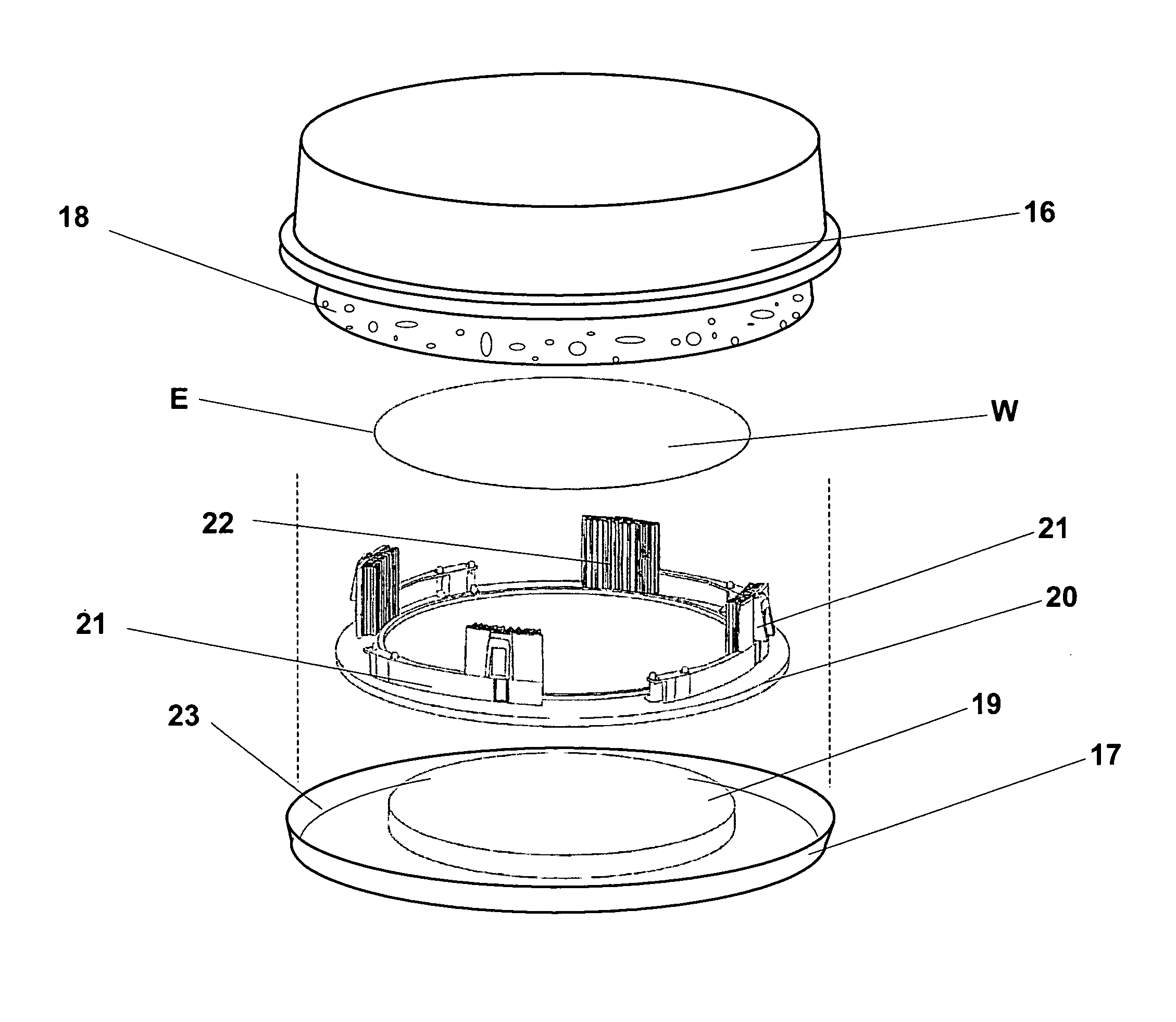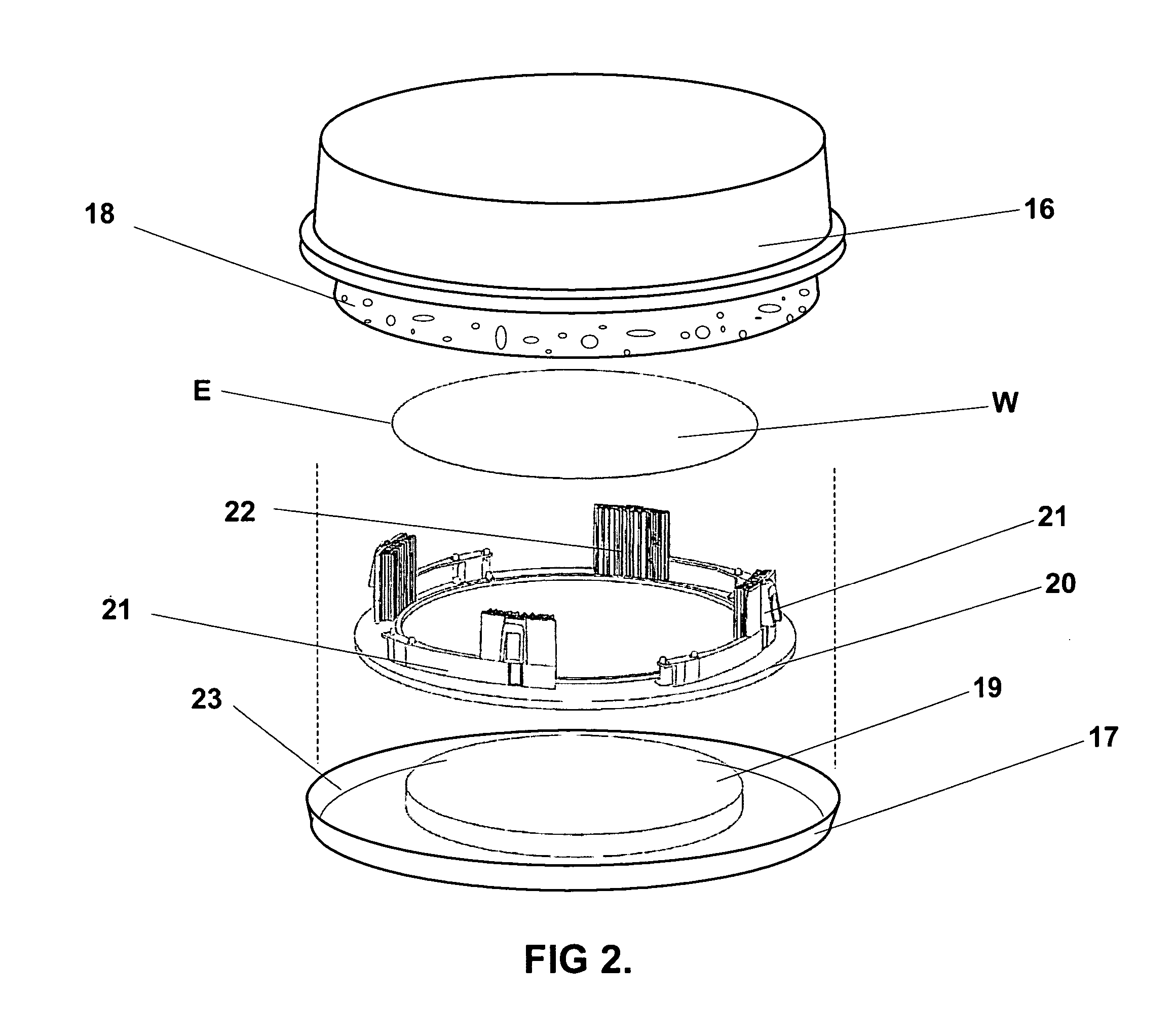In general,
present day transport media designed for packaging IC wafers are lacking the necessary features to address several problems common to advanced technology wafers during
insertion and transport.
These problems can manifest themselves in the form of disfigured connectors that include
wafer breakage, scratch damage as well as mobile
ion induced parametric failures.
Wafer shipping containers / boxes in combination with bags, outer
cardboard type boxes, cushions and separators that are not functionally coordinated nor objectively systematized to address wafer movement, Airborne Molecular Contaminants (AMCs), and vapor leakage during transport can cause yield problems to the semiconductor wafers.
The resulting wafer movement, when combined with wafers that utilize soft thin protective overcoats and elevated soft pads, caps and / or ground rings, can result in
scratching during the wafer
insertion and transport process.
Stacked wafers with elevated features may also transfer structural damage to other associated wafers if improper materials are selected with too soft or too stiff a
compressibility factor.
Partial loading of a box changes the
compressibility requirements of the system so that simply adding more cushions may not be the most appropriate solution.
These contaminates may lead to corrosive damage and / or
transistor inversion.
AMCs are exceptionally small in size they are generally corrosive and they carry a charge.
Through molecular migration, a charge build may occur over an active
transistor node resulting in
transistor inversion and a parametric failure.
There will be no clear path leading back to the transport media system as a source of the problem.
The
impact, depending on the weight of the wafer and the amount of
trapped air, will result in some amount of uneven force as the two surfaces come in contact with each other.
The allowed
lateral movement during the insertion will result in scratch damage.
It is known that such damage has been witnessed at the bevel edges of the wafers.
Scratch Damage: Smeared or Scratched Circuit Lead Scratches
During transport,
lateral movement of wafers within containers / boxes will scratch wafer surfaces during shipment.
The resulting scratches will cause damage to interconnect circuitry including smashing and disfiguring elevated connecting members such as ground rings, ball bond pads, and caps.
The same
lateral movement will also create shaving from the protective separators which further promotes scratch damage.
Corrosive damage to wafer surfaces is generally caused by packaging materials such as containers, bags, cushions and separators that out-gas or chemically deplete excessive Airborne Molecular Contaminants or AMCs.
Therefore,
moisture barrier bags having a high
Moisture Vapor
Transmission Rate or MVTR when combined with excessive AMCs will create corrosive residues causing latent defects to wafer surfaces.
Assuming no cracks or
crazing have occurred to the
passivation, the charge build that gathers above the transistor node may result in the transistor inverting, leading to a parametric
circuit failure.
Generally these AMCs have already attached themselves to the
oxide so that saw and
grind slurry and their respective cleanups accomplish little to achieve removal.
For wafers packaged within shipping containers, there are instances where bond pads and adjacent
passivation coatings will accumulate
contamination that appears as a
stain.
Clean rooms are teeming with AMCs that cannot be effectively removed by
HEPA filters.
A small amount of
chemical reaction takes place with the exposed aluminum or
copper surface, thereby resulting in a corrosive
stain in the area of bond pads as well as in any area where a mismatch between the photo-
resist and the PO
coating occurs.
Surfaces of bond pads that become excessively corroded while in transit from one location to another may become unnecessarily exposed to the condition of AMCs.
This damage is normally restricted to bond pad surfaces only and normally is associated with the presence of
moisture vapors.
This out-gassing may be linked to inorganic and organic type AMCs resulting in the corrosive damage.
Poor selection of packaging materials such as
open cell foam cushions and / or wafer separators treated with chemical additives that out-gas AMCs when combined with
moisture vapors can cause bond pads to become contaminated.
Present-day packaging technology can cause wafers to be damaged by
cushion over-packaging and / or under-packaging.
Wafer damage due to over-packaging is identified as resulting from stress-energy and will result in breakage usually during the packing process as the wafer box lid is attached or if the container is mishandled after closure.
Wafers damaged due to under-packaging can be caused by shock-energy if the container receives a sudden
impact.
Both of these type failures may also be impacted by the size and thickness of the wafer and the resulting ability to withstand these kinds of forces.
HEPA filtration like that used in most front ends does not remove AMCs from the environment.
 Login to View More
Login to View More  Login to View More
Login to View More 


